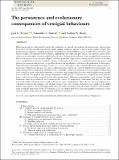Files in this item
The persistence and evolutionary consequences of vestigial behaviours
Item metadata
| dc.contributor.author | Rayner, Jack Gregory | |
| dc.contributor.author | Sturiale, Samantha Leigh | |
| dc.contributor.author | Bailey, Nathan William | |
| dc.date.accessioned | 2022-02-28T12:30:22Z | |
| dc.date.available | 2022-02-28T12:30:22Z | |
| dc.date.issued | 2022-08 | |
| dc.identifier | 277965721 | |
| dc.identifier | ce8a790d-5a74-4cd4-8a91-9b28806a0b49 | |
| dc.identifier | 000761203000001 | |
| dc.identifier | 85125274582 | |
| dc.identifier.citation | Rayner , J G , Sturiale , S L & Bailey , N W 2022 , ' The persistence and evolutionary consequences of vestigial behaviours ' , Biological Reviews of the Cambridge Philosophical Society , vol. 97 , no. 4 , pp. 1389-1407 . https://doi.org/10.1111/brv.12847 | en |
| dc.identifier.issn | 1464-7931 | |
| dc.identifier.uri | https://hdl.handle.net/10023/24959 | |
| dc.description | N.W.B. and J.G.R. were supported by the Natural Environment Research Council (NE/T0006191/1). | en |
| dc.description.abstract | Behavioural traits are often noted to persist after relaxation or removal of associated selection pressure, whereas it has been observed that morphological traits under similar conditions appear to decay more rapidly. Despite this, persistent non-adaptive, ‘vestigial’ behavioural variation has received little research scrutiny. Here we review published examples of vestigial behavioural traits, highlighting their surprising prevalence, and argue that their further study can reveal insights about the widely debated role of behaviour in evolution. Some vestigial behaviours incur fitness costs, so may act as a drag on adaptive evolution when that adaptation occurs via trait loss or reversal. In other cases, vestigial behaviours can contribute to future evolutionary trajectories, for example by preserving genetic and phenotypic variation which is later co-opted by selection during adaptive evolution or diversification, or through re-emergence after ancestral selection pressures are restored. We explore why vestigial behaviours appear prone to persistence. Behavioural lag may be a general phenomenon arising from relatively high levels of non-genetic variation in behavioural expression, and pleiotropic constraint. Long-term persistence of non-adaptive behavioural traits could also result when their expression is associated with morphological features which might be more rapidly lost or reduced. We propose that vestigial behaviours could provide a substrate for co-option by novel selective forces, and advocate further study of the fate of behavioural traits following relaxed and reversed selection. Vestigial behaviours have been relatively well studied in the context of antipredator behaviours, but they are far from restricted to this ecological context, and so deserve broader consideration. They also have practical importance, with mixed evidence, for example, as to whether predator/parasite-avoidance behaviours are rapidly lost in wildlife refuges and captivity. We identify important areas for future research to help determine whether vestigial behaviours essentially represent a form of evolutionary lag, or whether they have more meaningful evolutionary consequences distinct from those of other vestigial and behavioural traits. | |
| dc.format.extent | 19 | |
| dc.format.extent | 871955 | |
| dc.language.iso | eng | |
| dc.relation.ispartof | Biological Reviews of the Cambridge Philosophical Society | en |
| dc.subject | Non-adaptive behaviour | en |
| dc.subject | Preadaptation | en |
| dc.subject | Relaxed selection | en |
| dc.subject | Trait loss | en |
| dc.subject | Trait reversal | en |
| dc.subject | Vestigial trait | en |
| dc.subject | QH301 Biology | en |
| dc.subject | QH426 Genetics | en |
| dc.subject.lcc | QH301 | en |
| dc.subject.lcc | QH426 | en |
| dc.title | The persistence and evolutionary consequences of vestigial behaviours | en |
| dc.type | Journal item | en |
| dc.contributor.institution | University of St Andrews. School of Biology | en |
| dc.contributor.institution | University of St Andrews. St Andrews Bioinformatics Unit | en |
| dc.contributor.institution | University of St Andrews. Centre for Biological Diversity | en |
| dc.identifier.doi | 10.1111/brv.12847 | |
| dc.description.status | Peer reviewed | en |
This item appears in the following Collection(s)
Items in the St Andrews Research Repository are protected by copyright, with all rights reserved, unless otherwise indicated.

